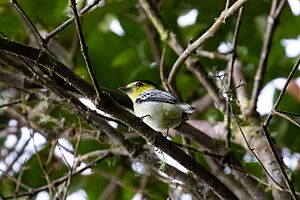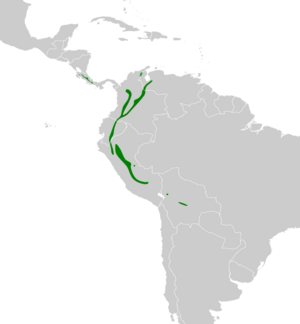Barred becard facts for kids
Quick facts for kids Barred becard |
|
|---|---|
 |
|
| Pachyramphus versicolor observed in Peru | |
| Conservation status | |
| Scientific classification | |
| Genus: |
Pachyramphus
|
| Species: |
versicolor
|
 |
|
The barred becard (Pachyramphus versicolor) is a small songbird found in the mountains of Central and South America. These colorful birds live in highland areas, from Costa Rica all the way down to parts of Ecuador and Bolivia. Scientists have studied them for a long time, and now they are placed in a bird family called Tityridae.
Contents
Discover the Barred Becard
The barred becard is a fascinating bird known for its unique looks and habits. It's a resident bird, meaning it stays in the same area all year round.
What Does the Barred Becard Look Like?
This small bird is about 12 centimeters (about 4.7 inches) long and weighs around 14 grams (about half an ounce). It has a clear ring around its eye, which helps it stand out!
- Males: Adult male barred becards have black feathers on their upper body. Their wings have a lot of white, making them easy to spot. The sides of their head and throat are a yellowish-green color, which fades to white on their belly. Their underparts also have fine black bars, like stripes.
- Females: Adult females have a grey crown (the top of their head) and nape (the back of their neck). Their upper body is olive-green, and their wings are mostly a reddish-brown color. Their greenish-yellow underparts also have fine, dusky (darker) bars.
- Young Males: Young male becards are not as brightly colored as the adults. They tend to be duller and greener, and their barring is not as strong.
Barred becards also have a distinct call. You might hear a soft but steady "weet weet weet weet" or a "teseep tesep tseep tseep."
Where Do Barred Becards Live?
Barred becards prefer to live in mountain forests. They are usually found in the middle and upper parts of the trees, known as the canopy. However, you might see them closer to the ground at the edges of the forest or in more open woodlands nearby.
These birds typically live at high altitudes, usually between 1,500 and 2,500 meters (about 4,900 to 8,200 feet) above sea level. Sometimes, they can be found even higher up, especially earlier in the year.
What Do Barred Becards Eat?
Barred becards are active hunters! They mostly eat large insects and spiders. They are very good at catching their prey right off the leaves while flying. They also enjoy small berries, which they often pick by hovering in the air.
You might see barred becards by themselves, in pairs, or with their family. They also often join up with other types of birds in what are called mixed-species feeding flocks. This means different bird species travel and feed together, which can help them find food and stay safe.
Family Life of the Barred Becard
The female barred becard is responsible for building the nest. She creates a large, round nest that looks like a ball, about 30 centimeters (about 12 inches) across. She uses plant materials to build it high up in a tree, usually in a fork of a branch, between 15 and 23 meters (about 49 to 75 feet) off the ground. The nest has a small entrance at the bottom.
A typical clutch (group of eggs) is two eggs. These eggs are brownish-white with dark brown blotches. They are usually laid between April and June. The female sits on the eggs to incubate them for about 18 to 20 days until they hatch. Once the chicks hatch, the male helps the female feed the young birds.


